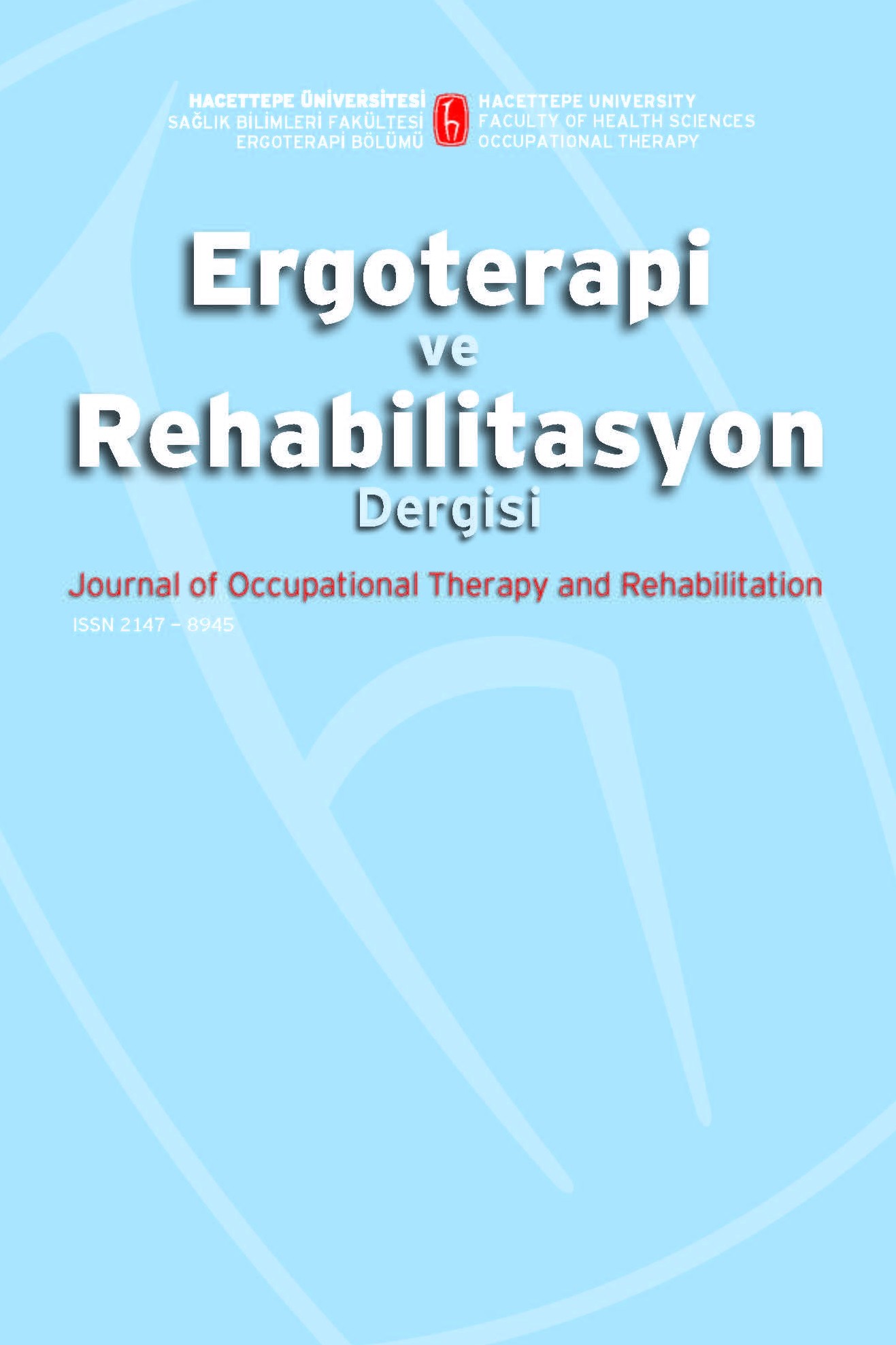Görme Keskinliği ile Fonksiyonel Denge Arasındaki İlişkinin İncelenmesi
Görme yetersizliği, Görme keskinliği, Postural denge
Investigation of the Relationship Between Visual Acuity and Functional Balance
Visual impairment, Visual acuity, Postural balance,
___
- Altunay Arslantekin, B. (2014). Görme yetersizliğinin psikomotor gelişim ile bağımsız hareket üzerindeki Etkileri ve Destekleyici Programlar. Ergoterapi ve Rehabilitasyon Dergisi, 2 (3 ), 165-175 .
- Anson, E., Rosenberg, R., Agada, P., Kiemel, T., & Jeka, J. (2013 ). Does visual feedback during walking result in similar improvements in trunk control for young and older healthy adults?. Journal of Neuroengineering and Rehabilitation , 10(1 ), 110.
- Atasavun Uysal, S., & Akı, E. (2009 ). Görme engelli çocukların mobilite düzeylerinin incelenmesi: Pilot çalışma. Fizyoterapi Rehabilitasyon, 20(3 ), 201-206.
- Bijur, P. E., Silver, W., & Gallagher, E. J. (2001 ). Reliability of the visual analog scale for measurement of acute pain. Academic Emergency Medicine , 8 (12 ), 1153- 1157 .
- Chen, E. W., Fu, A. S., Chan, K. M., & Tsang, W. W. (2011 ). The effects of Tai Chi on the balance control of elderly persons with visual impairment: a randomised clinical trial. Age and Ageing , doi: 10. 1093 /againg/afr146.
- Chen, E. W., Fu, A. S., Chan, K. M., & Tsang, W. W. (2012 ). Balance control in very old adults with and without visual impairment. European Journal of Applied Physiology, 112 (5 ), 1631-1636.
- Ekstrand, J., Wiktorsson, M., Oberg, B., & Gillquist, J. (1982 ). Lower extremity goniometric measurements: a study to determine their reliability. Archives of Physical Medicine and Rehabilitation , 63 (4), 171-175 .
- Franz, J. R., Francis, C. A., Allen, M. S., OConnor, S. M., & Thelen, D. G. (2015 ). Advanced age brings a greater reliance on visual feedback to maintain balance during walking. Human Movement Science , 40, 381-392 .
- Green, S.B., Salkind, N.J. & Akey, T.M. (2000). Using SPSS for Windows analayzing and undestanding data. 2nd. Ed.Prentice Hall, New Jersey, 208-232 .
- Kendall, F. P., McCreary, E. K., & Kendall, H. O. (1983 ). Muscles, Testing and Function: Testing and Function . Lippincott Williams and Wilkins.
- Khan, N. M., Lin, S., Guan, L., & Guo, B. (2014, December). A Visual Evaluation Framework for In - Home Physical Rehabilitation. In Multimedia (ISM), 2014 IEEE International Symposium on 237-240.
- Lamoureux, E., & Pesudovs, K. (2011 ). Vision - specific quality - of- life research: a need to improve the quality. American Journal of Ophthalmology, 151 (2 ), 195-197 .
- Lusk, K. E., Coakley, R., & Schwartz, T. L. (2014). Comprehensive pediatric low- vision rehabilitation: effective evaluations and treatment for very young children. Journal of American Association for Pediatric Ophthalmology and Strabismus , 18 (4), 34.
- Mason, H., & McCall, S. (Eds.). (2013 ). Visual impairment: Access to education for children and young people . Routledge.
- Matti, A. I., Pesudovs, K., Daly, A., Brown, M., & Chen, C. S. (2011 ). Access to low- vision rehabilitation services: barriers and enablers. Clinical and Experimental Optometry, 94(2 ), 181-186.
- McGraw, P., Winn, B., & Whitaker, D. (1995 ). Reliability of the Snellen chart. BMJ, 310(6993 ), 1481-1482 .
- Moon, S. J., Kim, Y. W., & Kim, T. H. (2012 ). The Effects of Balance Training with Visual Cue Deprivation on Gait Function in Patients with Stroke. Journal of the Korean Society of Physical Medicine , 7 (4), 411-421 .
- Noohu, M. M., Dey, A. B., & Hussain, M. E. (2014). Relevance of balance measurement tools and balance training for fall prevention in older adults. Journal of Clinical Gerontology and Geriatrics , 5 (2 ), 31-35 .
- Pascolini, D., & Mariotti, S. P. (2011 ). Global estimates of visual impairment: 2010. British Journal of Ophthalmology, 223-229 .
- Reed - Jones, R. J., Solis, G. R., Lawson, K. A., Loya, A. M., Cude - Islas, D., & Berger, C. S. (2013 ). Vision and falls: A multidisciplinary review of the contributions of visual impairment to falls among older adults. Maturitas , 75 (1 ), 22-28 .
- Rynearson, E., & Yu, S. (2013 ). Commentary on Functional Balance Assessment With Pediatric Balance Scale in Girls With Visual Impairment. Pediatric Physical Therapy, 25 (4), 466.
- Stevenson, T., & Tsang, R. (1996). Berg Balance Test. Physical Therapy, 76(10), 1124-1126.
- Swenor, B. K., Bandeen - Roche, K., Munoz, B. E., & West, S. K. (2014). Does walking speed mediate the association between visual impairment and self- report of walking disability? The Salisbury Eye Evaluation Study. Investigative Ophtalmology and Visual Science, 55 (5 ), 191 .
- Swenor, B. K., Munoz, B., & West, S. (2013 ). Does visual impairment affect mobility over time? The Salisbury Eye Evaluation Study. Investigative Ophthalmology & Visual Science, IO-13 .
- Willis, J. R., Vitale, S. E., Agrawal, Y., & Ramulu, P. Y. (2013 ). Visual impairment, uncorrected refractive error, and objectively measured balance in the United States. JAMA Ophthalmology, 131 (8 ), 1049-1056
- ISSN: 2147-8945
- Yayın Aralığı: 3
- Başlangıç: 2013
- Yayıncı: Hacettepe Üniversitesi Sağlık Bilimleri Fakültesi
Hatice ABAOĞLU, Gamze EKİCİ, Yasir ŞAFAK, Esra AKI
Demanslı Hastaya Bakım Veren Aile Bireylerinin Aktivite Performanslarının İncelenmesi
Görme Keskinliği ile Fonksiyonel Denge Arasındaki İlişkinin İncelenmesi
Meral HURİ, Banu Altunay ARSLANTEKİN, Onur ALTUNTAŞ, Esra AKI
Huzurevinde Çalışan Bakım Verenlerde Bel Okulunun Etkinliğinin İncelenmesi
